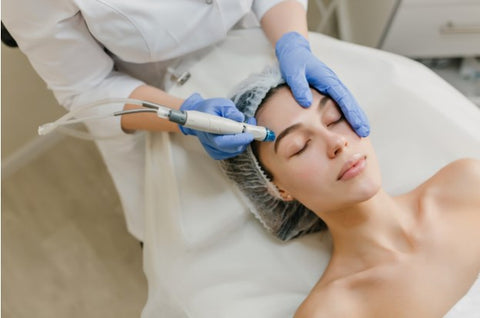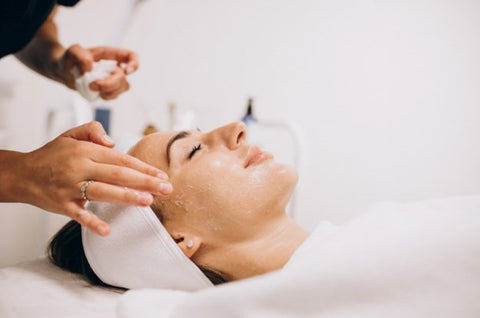Hydra Dermabrasion vs Microdermabrasion: A Comparison
Mar 08, 2024
We all want to feel confident in our skin, right? It's incredible how a little boost in appearance can lift our spirits. Gone are the days when people thought that young and glowing skin was only for the few lucky ones with solid genetics. With advancements in the skincare industry, newer methods have been introduced to make the skin bright and glowing.
If you have mastered the basics of your skincare routine—cleansing, moisturizing, and applying sunscreen—it's time to level up your game and learn about advanced methods.
Microdermabrasion and hydra dermabrasion are newly introduced skin care methods. Both processes exfoliate the skin, improve its texture, and remove dark spots, wrinkles, and fine lines. However, many people struggle to differentiate between the two and do not know which method will suit them the most.

So, if you're not quite caught up on the latest skincare buzz, don't worry! We're here to explain everything you need to know about hydra dermabrasion and Microdermabrasion.
Let's see the difference between microdermabrasion and hydra dermabrasion, how these methods work, and which one you should choose for yourself!
hydra dermabrasion – What is it?
The word "hydra" in hydra dermabrasion refers to its hydrating power. It is basically exfoliation, but a better version. It is an incredible combination of cleansing, exfoliation, extraction, and hydration.
hydra dermabrasion is a modern skincare treatment that can make your skin look younger and brighter. It can restore your skin's youthful look and boost your confidence.
The hydra dermabrasion treatment doesn't cause discomfort or require downtime and is suitable for all skin types! You can easily squeeze it into your lunch break or after work and go about your day as usual afterward, which is perfect!
Components Involved in Hydra Dermabrasion– How Does It Work?
It is a treatment done by skincare professionals to give your skin a thorough cleanse, hydration, and rejuvenation. They use a particular machine to gently exfoliate your skin, remove impurities from your pores, and infuse it with hydrating serums.
Let's see how it works in detail:
Skin Examination:
First, a skincare expert will check your skin to make sure it's the right treatment for you. Although it is noninvasive, it deeply cleans your pores, so it might not be suitable for everyone.
Skin Cleansing:
Deep cleansing is the one incredible thing about Hydra Dermabrasion that attracts most customers. It sucks out all the dirt, oil, and debris from your skin, especially on your forehead, nose, and chin areas. A mixture of lactic acid and algae is applied to clean, soften, and hydrate your skin.
Both these materials contain antioxidants that are helpful for skin rejuvenation and removal of dead cells. Moreover, algae prevent moisture loss from the skin and make it more hydrated.
Deeper Exfoliation for Glowy Skin:
After deep cleansing, skin exfoliation is done.
Exfoliation can be strong or gentle, depending on your skin type. Light exfoliation is preferred for sensitive skin. During exfoliation, a mixture of glycolic acid and salicylic acid is used to give your skin a good scrub, which helps prevent acne.
Getting Rid of Deep Gunk:
Next, a multi-action specialized skin solution called Beta HD™ is applied to the skin to get rid of even more gunk from your pores. This includes dirt, oil, makeup, blackheads, and sebum.
Beta HD is formulated for oily and congested skin but works excellently with any skin type. Your dermatologist may apply flower extract or honey to reduce the discomfort (if you feel any).

Serum Treatments
Here comes the main and most important step of a hydra dermabrasion. After cleansing, exfoliation, and extraction, special serums are gently applied to the skin.
These serums contain peptides, hyaluronic acid, and antioxidants to hydrate and protect your skin. Sometimes, they also have green tea extracts and horse chestnut seed to make your skin smoother and brighter.
Skin Rejuvenation with Red Light Therapy:
During red light therapy, beams of red light go deeper into your skin and increase the production of new skin cells (1).
Not only this, RLT also acts at cell levels in the skin and enhances the production of collagen and elastin proteins. More collagen and elastin means bright and soft skin.
P.S: You can use the hydra dermabrasion with different skin care products depending on your skin type.
What is Microdermabrasion?
If you want youthful, bright skin without fine lines and wrinkles, microdermabrasion is a good option.
The word "abrasion" means scraping away. It is a simple skin makeover treatment that gently scrubs away the epidermal (outermost) layer of your skin using a mildly rough tool. This tool blasts out tiny crystals of aluminium oxide or sodium bicarbonate along with suction. These crystals strip away the dead and dull layer of your skin. This helps remove dirt and oil and makes your skin look fresher. Plus, it encourages your skin to produce more collagen, which makes it firmer and more elastic. This makes your skin look fresh and glowing.
One of the best things about microdermabrasion is that it's safe for everyone. Even if you can't get other types of peels, you can usually still get microdermabrasion. It's also affordable and is a quick treatment that takes about 30 minutes.
Microdermabrasion helps with various skin issues like:
- Blemishes
- Pesky blackheads
- Dark patches on your skin
- Stretch marks
- Those fine lines and wrinkles
- Large pores
- Acne
Your dermatologist may also prescribe microdermabrasion, as scrubbing off some layers of your skin helps the skincare products penetrate deeper and do their job better.
Techniques And Tools Used in Microdermabrasion – How Does Microdermabrasion Work?
The Food and Drug Administration approved microdermabrasion in 1996, and since then, many different devices have been made for it.
Microdermabrasion is a treatment done in a skin doctor's office. It's often done by a licensed skincare pro, sometimes with a doctor nearby, depending on where you live.
You don't need any particular medicine to get it done.

During the treatment, you sit in a comfy chair, and the pro uses a small device (microdermabrasion machine) to gently rub away the top layer of your skin in the areas you want to treat. Then, they apply moisturizer and sunscreen to protect your skin.
Microdermabrasion is a kind of skin resurfacing, which means restoring the youthful complexion of the skin by removing the outer layer.
There are a few ways to do it, depending on the device used:
- Diamond-tip handpiece: This gently scrubs off dead skin cells (called dermabrasion) and sucks them away right away.
It's often used on delicate parts of your face, like near your eyes.
- Crystal microdermabrasion: This one sprays tiny crystals onto your skin to scrub away the top layer (called epidermis).
Just like the diamond one, it sucks away dead skin cells as it works.
- Hydradermabrasion: This is a newer way to do it. It combines scrubbing away the top layer of skin with putting unique products into your skin.
It helps make more collagen and brings more blood flow to your skin.
Hydra Dermabrasion vs Microdermabrasion
As you are now fully equipped with the basic knowledge about Hydra Dermabrasion and microdermabrasion, let's compare the two procedures:
A. Effectiveness in skin exfoliation:
hydra dermabrasion combines high pressure and suction to deeply cleanse the pores and exfoliate your skin.
On the other hand, microdermabrasion is more focused on stripping away the dead skin layer of the skin.
So, microdermabrasion is a better exfoliating method than hydra dermabrasion.
B. Impact on various skin types:
Hydra Dermabrasion is a more gentle procedure suitable for all skin types, including sensitive skin. It hydrates and nourishes the skin while exfoliating, making it a good option for dry or sensitive skin.
Microdermabrasion can be more abrasive, so it may not be suitable for sensitive or inflamed skin. It's generally better for people with normal to oily skin types.
C. Duration and frequency of treatments comparison:
A single Hydra Dermabrasion session typically takes around 30 to 60 minutes. For best results, getting a Hydra Dermabrasion is recommended every 4 to 6 weeks.
On the other hand, a microdermabrasion session usually takes about 30 minutes. To keep up your progress, you need to have one every 2 to 4 weeks.
D. Side effects and risks associated with each treatment:
hydra dermabrasion is generally a mild procedure, so it does not cause serious side effects. Some people may feel redness after the treatment; however, it usually goes away quickly.
If the treatment is done on an active sunburn, dermatological infection, or rash, it can aggravate the symptoms.
Since microdermabrasion can be a little harsh for some skin types, it can cause redness, swelling, and sensitivity to light. Some people may also experience bruising and a burning sensation after the treatment.
E. Cost comparison:
When it comes to cost, Hydra Dermabrasion is more expensive than microdermabrasion. Each session of hydra dermabrasion can cost around $150 to $300, depending on the location and provider.
Microdermabrasion is usually more affordable, with each session ranging from $75 to $200 per session.
However, you may need more sessions to achieve the desired results than Hydra Dermabrasion.
F. Customization Options:
Microdermabrasion is limited in terms of customization, mainly focusing on exfoliation.
Hydra Dermabrasion offers customizable treatment options tailored to individual skin concerns, allowing for personalized skincare solutions.
hydra dermabrasion Or Microdermabrasion: Which One is Better?
hydra dermabrasion is more advanced than microdermabrasion because it combines techniques like peels, pore cleaning, hydration, and adding nutrients into one treatment. Each step builds on the previous one, giving better results without being harsh on the skin.
In hydra dermabrasion, serums with beneficial ingredients are absorbed deeper into the skin than just applying them on the surface, which happens in microdermabrasion. Plus, hydra dermabrasion uses a gentler method than microdermabrasion, which can be harsh on the skin.
Which one should you choose?
- Microdermabrasion is a good option if you want an even-toned skin with a soft texture.
- Consider microdermabrasion i
- If you want to remove old acne scars and age spots.
- For people with acne, hydra dermabrasion is better because it's gentle and can treat acne without worsening it.
- Hydra Dermabrasion is the way to go if you have dry skin and dark spots and want to get rid of sunburns.
- If you want your skin to look great before an event, hydra dermabrasion is an excellent option to have glowing skin.
The Last Chapter
So, this was all about "hydra dermabrasion versus microdermabrasion" comparison. We hope this post can help you decide the best exfoliating treatment for you based on your skin type.
Both microdermabrasion and Hydra Dermabrasion are standard treatment methods in aesthetic dermatology. These make your skin smooth and bright.
However, there are a few things to consider before trying any method:
- Your skin type
- Side effects of the procedure,
- The cost
Take good care of your skin because, as someone said, "Having skin game in control is the first step on a ladder to self-confidence.”

